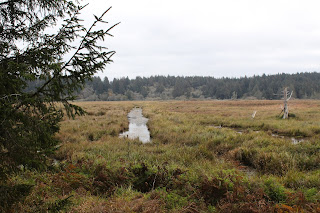It's Oregon Coast Time, in terms of our hiking itinerary. Gone are those hikes high up in our beloved Cascade Mountains, because rainy weather down in the Umpqua Valley translates to snow in the higher elevations. Therefore, we tend to find ourselves a bit more often on the coast where the weather is generally more conducive to the wonderful avocation of hiking, even though there is an increased probability of getting soaked by rain, buffeted by wind, or crapped on by a seagull. And out of all the destinations on the coast, Cape Arago is definitely one of our favorites because of its relative proximity to Roseburg and the always reliably spectacular scenery.
 |
| The ocean was quiet...too quiet |
Eons ago, the incredibly rocky and scenic shoreline at Cape Arago was formed when seismic events tilted the sea floor upward around 45 degrees. Nowadays, the resultant inclined sedimentary layers make for some incredible waves when the ocean kamikazes itself upon the rocks at high tide. Much photography ensues when this happens, and not just by me either, the area is quite popular with shutterbugs and hikers alike. Given the awesome ocean wavery in the area, we eagerly dashed up to the top of the forested bluffs overlooking Sunset Bay, fully prepared to be awed by the raging surf. Oops, we were ever so disappointed in the narcoleptically calm ocean, as still as a cat napping on a window sill, even though it was high tide. Heck, we might as well fold up our hiking poles and go home.
 |
| The beauty of the Cape Arago coast |
The normally restless surf was serene and peaceful but despite that sad failing, the coast nonetheless was quite beautiful. The jagged shore was sticking its many rocky fingers up the ocean's nostrils, figuratively speaking, and the trail followed the serrated shoreline, meaning we went in, out, and around a series of coves and gulches. When the route veered inland and away from the coast, we found ourselves ambling through a green coastal forest full of sprouting fungi and mushrooms.
 |
| What do you call a chair with feet? A toed stool! |
Rachel was photographing a mushroom when Dave said "Wow, he looks like a fun guy!". Fun guy? Fungi? Get it? Rachel apparently did because she groaned audibly. I asked her to pick up a couple of fungi specimens, telling her if she did so, she'd be a "woman with loose morels!" Dave and I high-fived each other in congratulatory exultation while Rachel quickly scurried off, refusing to walk any further in our company. Wow, Rachel must have thought she was being pun-ished, but she was correct in her assumption.
 |
| Trees, personally invested in the outcome of rising sea levels |
One aspect of climate change is rising sea levels and at Shore Acres, there are disturbing signs of the change mankind has wrought. Several times over the years, the trail has had to have been rerouted further inland because the old paths have tumbled into the sea as Oregon crumbles under the relentless maritime onslaught. In some places, they put fences on the old trails to keep hikers out but those fences have likewise tumbled into the sea as the coastline continues to erode. Also, the path sideswipes the old Shore Acres tennis court and now the erosion has eaten away at a corner of the old court. I can remember when not too long ago, it was safely out of reach, dozens of yards away from the ocean and eroding waves.
 |
| Tafoni formations at Shore Acres |
Over the ages, the waves have exposed a rocky bench sited below the tennis court, uncovering all sorts of phantasmagorical rock formations and an ossified log or two. The formations here have always reminded me of the cemetary scene in a horror movie where zombies emerge from their graves. But today the rock formations did not want to eat my brains (and good luck finding any!) so I scrambled down there to observe and photograph the concretions and tafoni (rock formations that look like Swiss cheese) on the rocky bench.
 |
| The woods were full of mushrooms |
The observation point at Shore Acres was amazingly still and quiet, both in terms of lack of people and crashing waves. But that's OK, there's nothing wrong with some peace and quiet and we enjoyed both of those things as we ducked into the woods and headed down to Simpson Beach. The woods were full of fungi and maybe a fun guy or two; much of my hiking time was spent lying on my belly on a muddy trail, taking photographs of the fungal splendors on the ground.
 |
| What do you call an amphibian's hammer? A toad's tool! |
As we hiked in turn to the Simpson Reef viewpoint and to Cape Arago itself, the clouds became darker and the wind picked up a little bit. Clearly a storm was coming in so cameras were mostly put away and we hied it quickly down the trail so as to arrive at the trailhead before the sky broke loose. But, I had one more for Rachel. "Hey Rachel, what do you call a place to eat oatmeal!" I just get a blank look and a pair of shrugged shoulders. "A mushroom!" Mush room? Mushroom, get it?" Sheesh, tough crowd, I tell you!
 |
| Bad weather is coming |
For more photos of this hike, please visit the Flickr album.






























